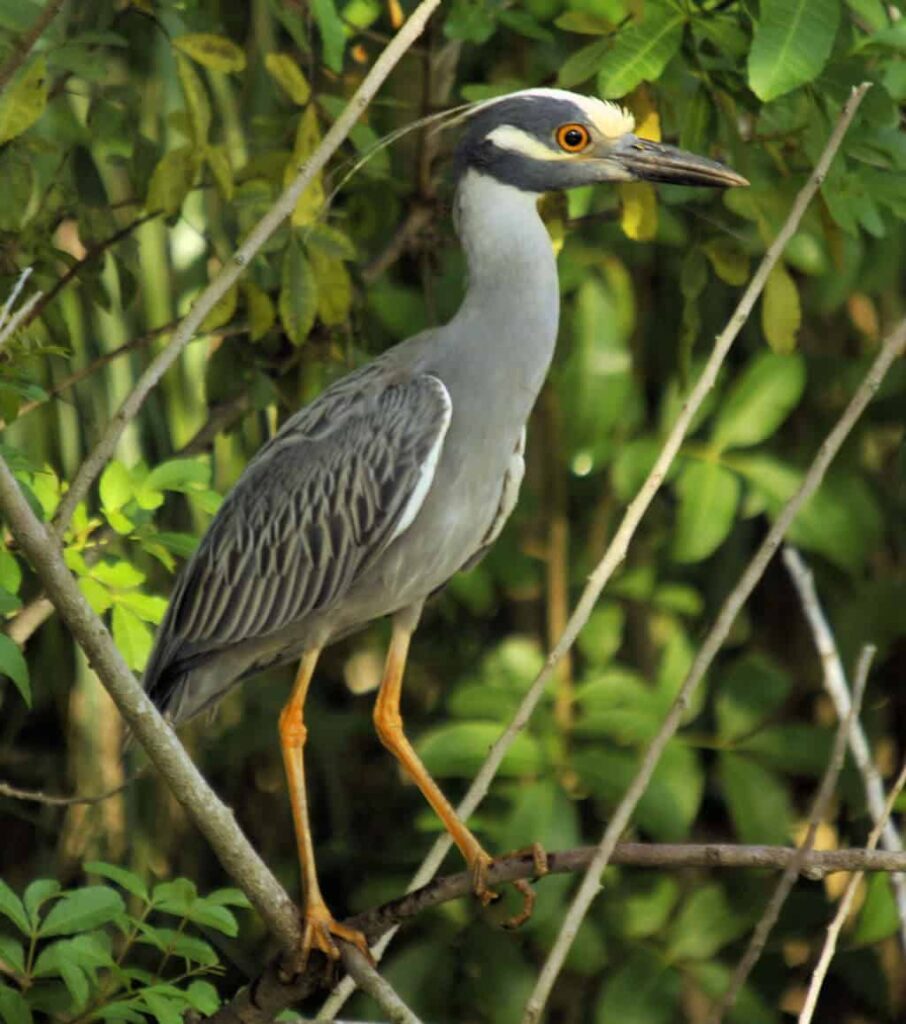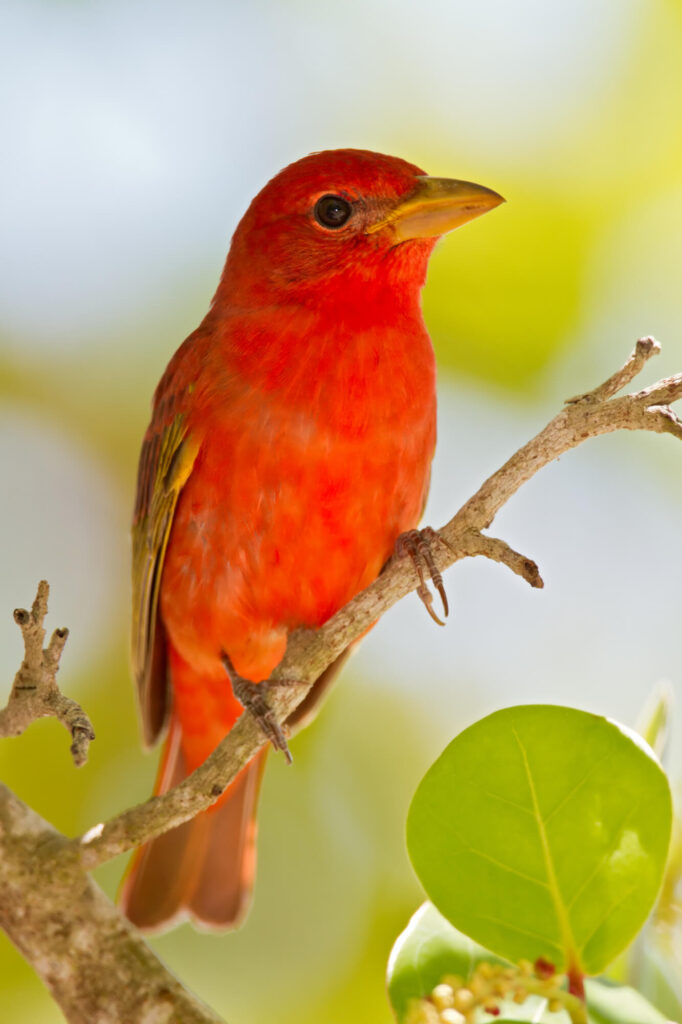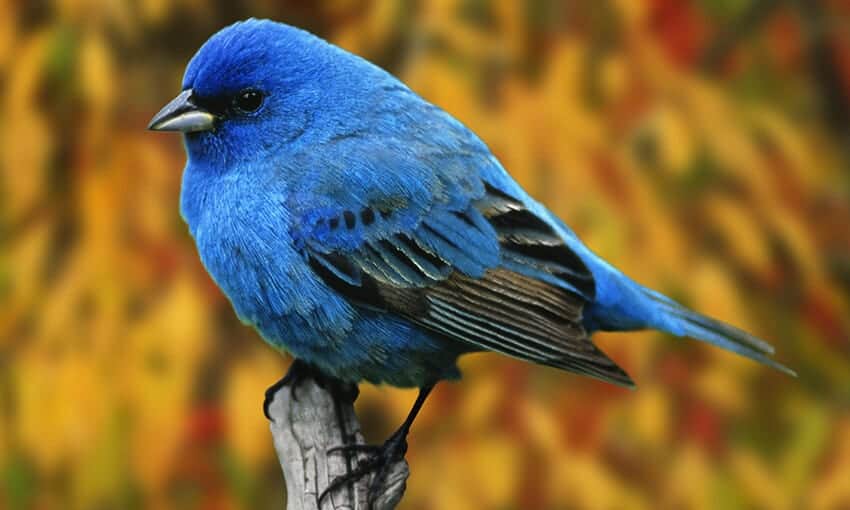Graceland, Dolly Parton, and The Great Smoky Mountains … these are just a few of the things that Tennessee, ‘America at its best’ as the state slogan says, is known for. But for birders, Tennessee is known for something else – is the end-point for countless birds during the summer. A viewing point for the great migration of so many species. A welcome oasis where the birds can finally rest their exhausted pectoral muscles after spending up to 600 miles a day airborne.
Along the ridgeline of the Southern Appalachian Mountains, Eastern Tennessee provides migratory birds with an important lifeline as the make their way into Mexico and further South towards their breeding grounds. On the Western side of Tennessee runs the mighty Mississippi River, the third-largest watershed in the world where thousands of small estuary-like systems are a refuge for traveling birds.
So, what kind of birds make Tennessee their road-side pull-off during migration?
SUMMER BIRDS
Great Egret

Length: 37-40in
Weight: 35.3oz
Wingspan: 51.6-57.1in
Colors: Fully white feathers and coloring with a distinct yellow-orange bill and stark black legs.
Quick Info: Not quite as grandiose as Great Blue Herons, but still a large bird. These birds wade shallow waters and hunt prey in a striking fashion, using the length of their necks to their advantage.
Snowy Egret
Length: 22.1-26in
Weight: 13.1oz
Wingspan: 39.4in
Colors: Clean white feathers with a black bill and legs and bright yellow feet and a patch of yellow skin near their eyes.
Quick Info: Like the Great Egrets, they focus on mudflats, wetlands, and other aquatic zones for their prey. But instead of extending their neck, they physically chase their prey.
Cattle Egret
Length: 18.1-22.1in
Weight: 9.5-18.1oz
Wingspan: 34.6-37.8in
Colors: Easily confused with Snowy Egrets, Cattles are also all white with a yellowish bill. During breeding season they will show golden/orange tints on their head, chest and back. Young Cattles can have dark legs and bills.
Quick Info: Less enticed by water, these egrets focus their hunting methods on insects and small animals in fields.
Green Heron
Length: 16.1-18.1in
Weight: 8.5oz
Wingspan: 25.2-26.8in
Colors: Robust green heads and dark gray wings with a full brown breast and wing. From a distance can easily be seen as just being all darkly colored but with better distance contrast is visible.
Quick Info: They focus their hunting in aquatic zones but don’t usually wade water like other egrets/herons.
Black-crowned Night-Heron
Length: 22.8-26in
Weight: 25.6-35.8oz
Wingspan: 45.3-46.5
Colors: Light gray bodies with black backs and a black crown. Juveniles might have spots on their wings and might have some yellow on their bills.
Quick Info: At first glance it might not look like a heron but upon further inspection they are simply a stout-looking heron. They rely on wetlands for their prey source.
Yellow-crowned Night-Heron

Length: 21.6-27.6in
Weight: 22.9-28.2oz
Wingspan: ~40-45in9
Colors: Mixed gray feathering with a black head and bright white cheeks. Yellow-orange legs and a yellowish-crown.
Quick Info: These birds target crustaceans as their main food source, like crabs and crayfish, and use the typical “stalking” hunting type that many herons use.
Osprey

Length: 21.3-22.8in Weight: 49.4-70.5oz Wingspan: 59.1-70.9in
Colors: Brown tops and white bottoms, Ospreys stand out from other raptors for their excess white coloring. A noticeable brown stripe runs on each cheek back from the eye.
Quick Info: Expert fishing skills, Ospreys are known to hunt fish in shallow near-shore (or shallow freshwater) habitats.
Yellow-Billed Cuckoo
Length: 10.2-11.8in Weight: 1.9-2.3oz Wingspan: 15.0-16.9in
Colors: Soft, buttery brown on their backs and a creamy white on the their chest and bellies. The bottom of their tail has distinct white and black dots/streaks and a soft orange tint on the tips of their wings.
Quick Info: Extremely vocal and active birds, they focus on hunting for large caterpillars in the canopies of trees. But they hunt in a slow and concise manner, making them a bit stealthy for observation as they sometimes go unnoticed.
Common Nighthawk
Length: 8.7-9.4in
Weight: 2.3-3.5oz
Wingspan: 20.9-22.4in
Colors: Incredibly well camouflaged with a blanket of complex patterns of gray, white and black. Wings have a strong white strip further towards the tip of the wing and a white throat.
Quick Info: In the mornings and evenings these birds come out to play, often flying in large looping designs but during the day they are virtually impossible to spot, hiding away in the branches of trees.
Chimney Swift
Length: 4.7-5.9in
Weight: 0.6-1.1oz
Wingspan: 10.6-11.8in
Colors: Mixing of dark brown shades with a lighter throat area. Against certain lighting they can look entirely black.
Quick Info: Rapid wingbeats and quick erratic movements make them able to navigate tight spaces. Like the name suggests, nesting sites include vertical crevices in dim areas with ventilation.
Ruby-throated Hummingbird

Length: 2.8-3.5in
Weight: 0.1-0.2oz
Wingspan: 3.1-4.3in
Colors: Bright green colors combined with gray and white and a glistening red throat.
Quick Info: Incredible control over movements. Can seemingly stop on a whim even during flight and switch to hovering.
Eastern-Wood Pewee

Length: 5.9in
Weight: 0.3-0.7oz
Wingspan: 9.1-10.2in
Colors: A generally nondescript bird, light gray with darker wings and a tinted white throat and chest. Tiny hint of orange on the bottom of the bill.
Quick Info: Efficent hunters, these little birds patiently wait for their prey to cross paths with them.
Great Crested Flycatcher
Length: 6.7-8.3in Weight: 0.9-1.4oz Wingspan: 13.4in
Colors: A diverse collection of colors are found on these birds. Reddish/brown on the tip with gray and bright yellow feathering on the belly and chest and rusted orange striping along the inside of the wings.
Quick Info: Much like the Pewees, they use a sit-and-wait hunting method (near the canopy), waiting for insects to come to then rather than actively searching for prey.
Eastern Kingbird
Length: 7.5-9.1in
Weight: 1.2-1.9oz
Wingspan: 13-15in
Colors: Contrasting black and white on the top and bottom of the bird and a noticeable white tip on their tails.
Quick Info: They are traditional visual hunters, targeting flying insects in midair travel.
White-eyed Vireo
Length: 4.3-5.1in
Weight: 0.3-0.5oz
Wingspan: 6.7in
Colors: Distinct yellow rings around the eyes and bright white eyeballs with brushed yellow sides and a white head and chest.
Quick Info: Instead of flying this bird hunts by using small hops and flutters from place to place searching for insects.
Red-eyed Vireo
Length: 4.7-5.1in
Weight: 0.4-0.9oz
Wingspan: 9.1-9.8in
Colors: Cream, olive-green on the top and white on the bottom with a strong gray head and bright red eyes.
Quick Info: Blending in with the green canopies, these birds follow the “you-come-to-me” theory of hunting.
Purple Martin

Length: 7.5-7.9in
Weight: 1.6-2.1oz
Wingspan: 15.3-16.1in
Colors: Striking blue-purple bodies with dark wings and a black patch in front of the eyes.
Quick Info: Midair hunters of large insects like dragonflies and other flying insects.
Northern Rough-winged Swallow
Length: 4.7-5.9in
Weight: 0.3-0.6oz
Wingspan: 10.6-11.8in
Colors: Very generically colored, basically a single brown tone on top with a more cream-white on the bottom and a black beak.
Quick Info: More methodical than most swallows, hunting midair for insects rather than waiting for insects to make their way to it.
Barn Swallow
Length: 5.9-7.5in
Weight: 0.6-0.7oz
Wingspan: 11.4-12.6in
Colors: Shining blue backs with rusted red and oranges on its belly and underparts. In flight, you may see white dots on the underside of the tail.
Quick Info: Acrobatic flyers and hunters, picking insects out of the air. Forages for aquatic insect oviposition sites.
Blue-gray Gnatcatcher
Length: 3.9-4.3in
Weight: 0.2-0.3oz
Wingspan: 6.3in
Colors: Soft, paler shades of blue and gray all over it;s body with distinct black lining above it’s eyes, small white striping on the wings and a white undertail.
Quick Info: Stealthy, sneaky hunters, often stealing catches from spiderwebs and other insect- havens.
Wood Thrush
Length: 7.5-8.3in
Weight: 1.4-1.8oz
Wingspan: 11.8-13.4in
Colors: Red and brown tints on the back with strong brown/brown spots on the chest/breast with white feathering.
Quick Info: Spending winters in Central American tropical forests and summers in Tennessee.
Gray Catbird

Length: 8.3-9.4in
Weight: 0.8-2oz
Wingspan: 8.7-11.8in
Colors: Matte gray with some white and rusted striping down the tail as well as a brown/black tip of the head.
Quick Info: Steering clear of open field flight, these birds hop and take small flights from cover to cover, searching for prey.
Prothonotary Warbler
Colors: Incredible glowing yellow with blue-tinted wings and a smudged black-yellow back.
Quick Info: Loves hunting along slow moving water, using fallen logs and foliage as stopping points.
Common Yellowthroat
Length: 4.3-5.1in
Weight: 0.3oz
Wingspan: 5.9-7.5in
Colors: Yellow/gold breast with black and white stripes along face and a glossy brown-gold back and wings.
Quick Info: Staying low to the ground in dense vegetation searching for insects.
Northern Parula
Length: 4.3-4.7in
Weight: 0.2-0.4oz
Wingspan: 6.3-7.1in
Colors: Blue tinted heads and upper wings with yellow breast and chin and tiny white half eye- rings.
Quick Info: Hopping along the upper layers of the canopy in search for insects high in caloric value.
Yellow-breasted Chat
Length: 7.1in
Weight: 0.8-1.1oz
Wingspan: 9.8in
Colors: Yellow chest and bellies with white stripes on the upper and lower face (above and below bill line). Grayish tints elsewhere.
Quick Info: Very loud and like many other birds in the same size range, focuses on undercanopy foraging for insects.
Summer Tanager

Length: 6.7in
Weight: 1.1oz
Wingspan: ??
Colors: Male and females are different colors. The former being bright red and the latter a soft- golden yellow.
Quick Info: Patiently waiting for flying insects to fly near their perches and taking advantage of close encounters.
Scarlet Tanager
Length: 6.3-6.7in Weight: 0.8-1.3oz
Wingspan: 9.8-11.4in
Colors: Vibrant red with black wings and tails. Females carry a different coloring being a soft- yellow with darker wings.
Quick Info: Not only focusing on insects but also interested in fruit, these birds forage among the canopy to the forest floor for their food source.
Chipping Sparrow
Length: 4.7-5.9in
Weight: 0.4-0.6oz
Wingspan: 8.3in
Colors: Bright rusted crown with silvery underparts and a black stripe through the side of the face. Orange and black striped wings.
Quick Info: Ground dwelling foragers, chipping sparrows focus on what the soil can provide.
Rose-breasted Grosbeak

Length: 7.1-8.3in
Weight: 1.4-1.7oz
Wingspan: 11.4-13.0in
Colors: Strong black backs and white bellies with a red V on their chest and white spotting on the wings.
Quick Info: Small, stocky bills make it easier for these birds to consume berries and seeds.
Blue Grosbeak
Length: 5.9-6.3in
Weight: 0.9-1.1oz
Wingspan: 11in
Colors: Full blue-purple with black eyes and some light brown tipping on the wings.
Indigo Bunting

Length: 4.7-5.1in
Weight: 0.4-0.6oz
Wingspan: 7.5-8.7in
Colors: Shifting shades of blue all over with some softer blackish striping on the wings and a small black patch in front of the eyes.
Quick Info: During perching, they like to move their tails from side to side – a unique tick of the species.
Orchard Oriole

Length: 5.9-7.1in
Weight: 0.6-1.0oz
Wingspan: 9.8in
Colors: Black backs and head with a dark red chest and shoulder.
Quick Info: Often these birds share food interested with hummingbirds, even going as far as to feed from hummingbird feeders.
Baltimore Oriole

Length: 6.7-7.5in
Weight: 1.1-1.4oz
Wingspan: 9.1-11.8in
Colors: Bright orange with a black head and white stripes down the wings.
Quick Info: Using slow, methodical flights to pick fruit from the vine and catch flying insects.
SPRING AND FALL
Spotted Sandpiper
Length: 7.1-7.9in
Weight: 1.2-1.8oz
Wingspan: 14.6-15.8in
Colors: Big dark spotting on the white breast with a distinct orange bill and brown back with a faint brown stripe through the eye.
Quick Info: Usually solitary birds, they forage while walking with a fast pace and pouncing towards prey.
Citations:
- 1 “Five Fantastic Bird Migration Facts.” American Bird Conservancy, 29 Aug. 2019, abcbirds.org/blog/five-fantastic-bird-migration-facts/.
- 2 “Fun Facts.” Experience Mississippi River, 5 Apr. 2018, experiencemississippiriver.com/interactive-tools/fun-facts/.
- 3 “Great Egret Identification, All About Birds, Cornell Lab of Ornithology.” All About Birds, Cornell Lab of Ornithology, www.allaboutbirds.org/guide/Great_Egret/id.
- 4 “Snowy Egret Identification, All About Birds, Cornell Lab of Ornithology.” , All About Birds, Cornell Lab of Ornithology, www.allaboutbirds.org/guide/Snowy_Egret/id.
- 5 “Cattle Egret Identification, All About Birds, Cornell Lab of Ornithology.” All About Birds, Cornell Lab of Ornithology, www.allaboutbirds.org/guide/Cattle_Egret/id.
- 6 “Green Heron Identification, All About Birds, Cornell Lab of Ornithology.” All About Birds, Cornell Lab of Ornithology, www.allaboutbirds.org/guide/Green_Heron/id.
- 7 “Black-Crowned Night-Heron Identification, All About Birds, Cornell Lab of Ornithology.” All About Birds, Cornell Lab of Ornithology, www.allaboutbirds.org/guide/Black- crowned_Night-Heron/id.
- 8 “Yellow-Crowned Night-Heron Identification, All About Birds, Cornell Lab of Ornithology.” All About Birds, Cornell Lab of Ornithology, www.allaboutbirds.org/guide/Yellow- crowned_Night-Heron/id.
- 9 “Yellow-Crowned Night Heron – Nyctanassa Violacea.” NatureWorks – Yellow-Crowned Night Heron, www.nhptv.org/natureworks/yellowcrownednightheron.htm#1.
- 10 “Osprey Identification, All About Birds, Cornell Lab of Ornithology.” All About Birds, Cornell Lab of Ornithology, www.allaboutbirds.org/guide/Osprey/id.
- 11 “Yellow-Billed Cuckoo Identification, All About Birds, Cornell Lab of Ornithology.” All About Birds, Cornell Lab of Ornithology, www.allaboutbirds.org/guide/Yellow- billed_Cuckoo/id.
- 12 “Common Nighthawk Identification, All About Birds, Cornell Lab of Ornithology.” All About Birds, Cornell Lab of Ornithology, www.allaboutbirds.org/guide/Common_Nighthawk/id.
- 13 “Chimney Swift Identification, All About Birds, Cornell Lab of Ornithology.” All About Birds, Cornell Lab of Ornithology, www.allaboutbirds.org/guide/Chimney_Swift/id.
- 14 “Ruby-Throated Hummingbird Identification, All About Birds, Cornell Lab of Ornithology.” All About Birds, Cornell Lab of Ornithology, www.allaboutbirds.org/guide/Ruby- throated_Hummingbird/id.
- 15 “Eastern Wood-Pewee Identification, All About Birds, Cornell Lab of Ornithology.” All About Birds, Cornell Lab of Ornithology, www.allaboutbirds.org/guide/Eastern_Wood-Pewee/id.
- 16 “Great Crested Flycatcher Identification, All About Birds, Cornell Lab of Ornithology.” All About Birds, Cornell Lab of Ornithology, www.allaboutbirds.org/guide/Great_Crested_Flycatcher/id.
- 17 “Eastern Kingbird Identification, All About Birds, Cornell Lab of Ornithology.” All About Birds, Cornell Lab of Ornithology, www.allaboutbirds.org/guide/Eastern_Kingbird/id.
- 18 “White-Eyed Vireo Identification, All About Birds, Cornell Lab of Ornithology.” All About Birds, Cornell Lab of Ornithology, www.allaboutbirds.org/guide/White-eyed_Vireo/id.
- 19 “Red-Eyed Vireo Identification, All About Birds, Cornell Lab of Ornithology.” All About Birds, Cornell Lab of Ornithology, www.allaboutbirds.org/guide/Red-eyed_Vireo/id.
- 20 “Purple Martin Identification, All About Birds, Cornell Lab of Ornithology.” All About Birds, Cornell Lab of Ornithology, www.allaboutbirds.org/guide/Purple_Martin/id.
- 21 “Northern Rough-Winged Swallow Identification, All About Birds, Cornell Lab of Ornithology.” All About Birds, Cornell Lab of Ornithology, www.allaboutbirds.org/guide/Northern_Rough-winged_Swallow/id.
- 22 “Barn Swallow Identification, All About Birds, Cornell Lab of Ornithology.” All About Birds, Cornell Lab of Ornithology, www.allaboutbirds.org/guide/Barn_Swallow/id.
- 23 “Blue-Gray Gnatcatcher Identification, All About Birds, Cornell Lab of Ornithology.” All About Birds, Cornell Lab of Ornithology, www.allaboutbirds.org/guide/Blue- gray_Gnatcatcher/id.
- 24 “Wood Thrush Identification, All About Birds, Cornell Lab of Ornithology.” , All About Birds, Cornell Lab of Ornithology, www.allaboutbirds.org/guide/Wood_Thrush/id.
- 25 “Gray Catbird Identification, All About Birds, Cornell Lab of Ornithology.” All About Birds, Cornell Lab of Ornithology, www.allaboutbirds.org/guide/Gray_Catbird/id.
- 26 “Prothonotary Warbler Identification, All About Birds, Cornell Lab of Ornithology.” All About Birds, Cornell Lab of Ornithology, www.allaboutbirds.org/guide/Prothonotary_Warbler/id.
27 “Common Yellowthroat Identification, All About Birds, Cornell Lab of Ornithology.” All About Birds, Cornell Lab of Ornithology, www.allaboutbirds.org/guide/Common_Yellowthroat/id.
- 28 “Northern Parula Identification, All About Birds, Cornell Lab of Ornithology.” All About Birds, Cornell Lab of Ornithology, www.allaboutbirds.org/guide/Northern_Parula/id.
- 29 “Yellow-Breasted Chat Identification, All About Birds, Cornell Lab of Ornithology.” All About Birds, Cornell Lab of Ornithology, www.allaboutbirds.org/guide/Yellow- breasted_Chat/id.
- 30 “Summer Tanager Identification, All About Birds, Cornell Lab of Ornithology.” All About Birds, Cornell Lab of Ornithology, www.allaboutbirds.org/guide/Summer_Tanager/id.
- 31 “Scarlet Tanager Identification, All About Birds, Cornell Lab of Ornithology.” All About Birds, Cornell Lab of Ornithology, www.allaboutbirds.org/guide/Scarlet_Tanager/id.
- 32 “Chipping Sparrow Identification, All About Birds, Cornell Lab of Ornithology.” All About Birds, Cornell Lab of Ornithology, www.allaboutbirds.org/guide/Chipping_Sparrow/id.
- 33 “Rose-Breasted Grosbeak Identification, All About Birds, Cornell Lab of Ornithology.” All About Birds, Cornell Lab of Ornithology, www.allaboutbirds.org/guide/Rose- breasted_Grosbeak/id.
- 34 “Blue Grosbeak Identification, All About Birds, Cornell Lab of Ornithology.” All About Birds, Cornell Lab of Ornithology, www.allaboutbirds.org/guide/Blue_Grosbeak/id.
- 35 “Indigo Bunting Identification, All About Birds, Cornell Lab of Ornithology.” All About Birds, Cornell Lab of Ornithology, www.allaboutbirds.org/guide/Indigo_Bunting/id.
- 36 “Orchard Oriole Identification, All About Birds, Cornell Lab of Ornithology.” All About Birds, Cornell Lab of Ornithology, www.allaboutbirds.org/guide/Orchard_Oriole/id.
- 37 “Baltimore Oriole Identification, All About Birds, Cornell Lab of Ornithology.” All About Birds, Cornell Lab of Ornithology, www.allaboutbirds.org/guide/Baltimore_Oriole/id.
- 38 “Spotted Sandpiper Identification, All About Birds, Cornell Lab of Ornithology.” All About Birds, Cornell Lab of Ornithology, www.allaboutbirds.org/guide/Spotted_Sandpiper/id.

